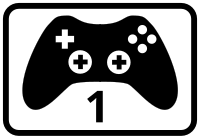Single player
The single player mode ( english single player or single player ) is a mode in video games , in which you play without further human with or against players. It is fundamentally different from the multiplayer mode (multiplayer).
Simulated multiplayer mode
In single player mode, the player deals with the game system. This argument can be modeled on an argument in a multiplayer game. The personification of the program that takes place helps to clarify the goals and motivation for the discussion.
Single player modes, which simulate multiplayer mode with the help of computer-controlled opponents, are often found in game genres where competition is paramount. Examples are beat 'em ups or racing games .
Interactive narration in single player mode
Most of the time, as a single player, you play a story given by the developer in many areas to the end of the game, in contrast to the multiplayer mode, where the player usually competes against human players without a clearly defined course of action. The playable story in single player mode is also known as a mission or campaign (the latter especially in strategy games ). By structuring the game, for example into individual levels , the game designer has greater control over the challenges the player encounters in the game. As a result, for example, the adjustment of the level of difficulty can be handled differently than in multiplayer titles and the flow of information to the player can be controlled in order to give him a certain planning option. In addition, single-player titles can include individual influences of the season as the insertion of not playing (often can via a button in the game, the time will be stopped) or playing cutscenes .
Social interaction
In principle, single-player titles per se do not initially include the possibility of direct social interaction. However, if such games are played in the presence of other people, for example in the form of an arcade machine in a restaurant, this may result in spontaneous social interaction between the player and the viewer. Other options include the use of highscore tables , which allow the game performance to be compared. In addition, there are connection points between players of the same single player title due to the virtual reality of the game. This can lead to social interactions around the game, for example in the form of the exchange of individual game experiences or mutual assistance, especially in games with narrative structures or opportunities for exploration that do not have to be obvious to every player ( e.g. Easter eggs ). The assistance collected from the players can be published on the Internet as a complete solution. A form of exchange derived from this are game sessions recorded on video by players and verbally commented on during them (so-called Let's Play videos ).
A single player mission can be made multi -player compatible through the co-op mode . Several players connected via a network take part in a game which, in terms of structure, corresponds to a typical single player mission.
Individual evidence
- ↑ a b c Staffan Björk, Jussi Holopainen: Patterns in Game Design . Charles River Media, Boston MA 2005, ISBN 1-58450-354-8 , pp. 344-345 ( online view ).
- ↑ Hans-Joachim Backe: Structures and functions of storytelling in computer games. A typological introduction (= Saarbrücker contributions to comparative literary and cultural studies. Vol. 44). Königshausen & Neumann, Würzburg 2008, ISBN 978-3-8260-3986-7 , p. 317 ff. (Also: Saarbrücken, Universität, Dissertation, 2008), online
